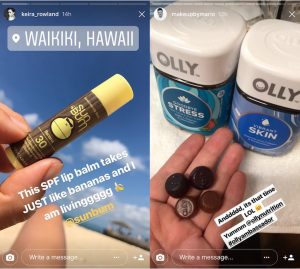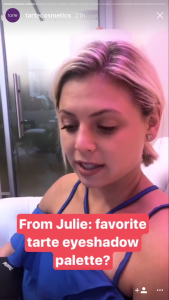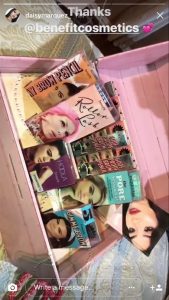Remember the days when you tried to mimic a makeup look you saw in a magazine?
Maybe you loved the layered eyeshadow you saw on a model in an ad. Maybe you followed, to the letter, the step-by-step process laid out in an article that promised the perfect winged eyeliner.
Whether you were going it completely on your own or heeding the advice of beauty editors, the result was always the same: a mess.
Why? Because one-dimensional tutorials are incredibly hard to follow. There’s a world of difference between seeing a flat image accompanied by written directions and actually watching someone apply makeup.
Beauty brands and influencers know the power of visual, illustrative content. Plus, non-celebrities are more influential than better-known names. According to Collective Bias, 30% of consumers are more likely to buy a product that a “regular” person promoted.
Beauty influencers are reigning supreme on social media, both on their own accounts and by being featured by big brands.
How do they piece together their makeup tutorials? What do they do in between instructional videos to keep their audience entertained? We’re about to tell you.
8 Types of Makeup Tutorials
Makeup tutorials span all sorts of beauty-related topics, from tricks and techniques to product and brush recommendations. They can help fans with classic or on-trend looks. They can also create over-the-top styles for holidays or special events, or just to let viewers live vicariously for a little while. Here are 8 types of makeup tutorials to consider.
- Show how to upgrade a basic look. For example, instead of simply applying red lipstick, show how to contour your lips with various shades of red.
- Nail something tricky that other makeup tutorials don’t seem to focus on or that you haven’t emphasized in the past. For example, makeup tutorials often show all-over application, but they don’t always hone in on one particular thing, like drawing bright red lips or cat eye liner.
- Focus on skin type to draw in certain audience members. For example, you can talk about matte makeup for oily skin or dewy makeup for dry skin. You can also show viewers how to find the right color to match or complement their skin tone, like when Sephora showed off a number of shades from their nude lipstick crayon collection or when Huda Kattan demonstrated her line’s palette.

- Turn an everyday look into something glamorous. For example, show how to go from day to night without having to completely redo your makeup.
- Prep for an event as your fans follow along. (If you don’t have an event to get ready for, you can do something as simple as prepping for a regular work day.) Audiences love seeing the before-and-after, especially since so many beauty influencers seem to look perfect all the time. Watching the progression and seeing how much work you have to put into your look makes you relatable. Check out the before and after that Maybelline showed using their green Master Camo color-correcting pen.

- Transform your face into a work of art. This can be either the entire face or a portion of it (like just the eyes or lips). This type of tutorial doesn’t have to be practical – it can be a look that’s appropriate just for the runway or Halloween, for example.
- Fix a mistake. Applying makeup correctly is one thing; fixing a boo-boo is another. Show your audience what to do when they overdraw their lipstick, botch up their eyeliner or cry tear streaks into their foundation.
- Make sure to always save your best content to your phone. After one month, put together your favorite mini-tutorials to create a new Story. This is a way to repurpose old content and to reach audience members who you may have missed the first time around. Technically, Stories only lets you post content from your phone that’s from the last 24 hours. There’s a workaround for this, though:
- Make sure that Save Original Photos is enabled in Instagram (from the Options menu).
- Put your phone on Airplane Mode.
- Go through the process of posting to regular Instagram (not Stories). When you try to share the post, Instagram won’t allow it because your phone is in Airplane Mode.
- Click the “X” to remove the post.
- Turn off Airplane Mode.
Now, the content you just tried to upload to Instagram will show up in your recent content, which will allow you to add it to your Story.
Become a Jumper Media Insider
You’ll get weekly social marketing motivation, all the latest hacks, and first dibs on exclusive giveaways and other subscriber-only resources you can’t get anywhere else.
17 Tips for Makeup Tutorials
Knowing what you’re going to teach your audience is just a starting point. You have to plan ahead to figure out the best way to deliver the information in a palatable way; to maximize exposure, and to get your viewers to take the next step.
- Storyboard the tutorial ahead of time to create a cohesive Story. Figure out how many steps you’ll need. Decide which steps require a video and which will be fine with just a photo. Write out the descriptions you’ll be using.
- It’s fine to use a voice-over if you want, but assume that some people aren’t going to be able to watch your Story with the sound on. Even if you’ll be talking during the tutorial, you should also write out the steps.
- Introduce what the video is going to cover. You may even want to include a visual of the end result at the beginning of the video. This is how Benefit started their Instagram Story about brows.

- If you’re getting your inspiration from somewhere specific, show your audience. Christen Dominique started her Story with a photo of Selena Gomez, then replicated the look.

- Make sure your audience knows what they’ll need – go over products and brushes first instead of launching right into technique.
- Post incremental videos instead of trying to show everything in one 15-second video. Each step can be its own, independent video that you add, in succession, to your Story.
- Use numbers to clarify the steps.
- If there’s a particularly important point to make, mark it with a drawing. For example, if you want to clarify which direction to apply blush, draw an arrow.
- Name every product you use, including brushes. Make sure to tell your viewers not just the brand name but also the specific color name or number, as well as the brush number. Check out how Benefit named the pencil and the shade that was used to create this look.

- Make sure your viewers know which cosmetics and brushes are being used for what. You can even post an image to your Story with everything laid out and text next to each one for clarity.
- Give credit where credit’s due! Naming a brand isn’t enough – you should make sure to actually tag any brands that you mention. (If you’re playing music over your tutorial, you should also tag the artist and mention the name of the song.)
- Add a location sticker if you have a physical salon where customers can visit or if you’re at an event, like how Kandee Johnson geo-tagged her Story during a ULTA Beauty event.

- If you have a signature color that your audience associates with you, use it to add more branding to your Stories. For example, change your text and emoji colors to match your signature color.
- Show the progression at some point. If you want to show this sped up and in one video, use it either as a teaser on regular Instagram to encourage people to watch your story; as the introduction to your Story; or as the ending.
- Always include a call-to-action (CTA). If you want to get customers into your salon, your CTA can be, “For bookings in San Diego, contact Jane Doe at (555) 555-5555.” Or, your CTA can ask viewers to swipe up to see the full video on YouTube or to read an in-depth blog post about your technique. Benefit created a branded hashtag and asked users to tag their Instagram posts with it for the chance at a feature, while Roxette Arisa Howe offered a coupon code to encourage people to buy.

- At the end of the video, don’t forget to show the final result!
- Post to your regular Instagram feed to encourage people to view your latest tutorial. Not only will you possibly reach more people from your own audience, but you can max out your post with hashtags to potentially attract new followers and viewers.
Become a Jumper Media Insider
You’ll get weekly social marketing motivation, all the latest hacks, and first dibs on exclusive giveaways and other subscriber-only resources you can’t get anywhere else.
Whatever You Do, Don’t…
Don’t include so many steps that your viewers won’t be able to follow them. This comes down to knowing your audience. If you help with practical makeup application, though, make sure that what you’re using and teaching matches the makeup collection, budget and expertise of your followers.
Don’t over-explain. For example, if you’re going to be applying lipstick and the lipstick comes in a traditional lipstick vessel, you don’t need to point to the lipstick and then to your lips to clarify where it’s going to be applied. Assume your audience has a ground-level understanding of makeup; don’t dumb it down more than necessary.
Don’t put something in slow motion that doesn’t need to be slowed down. This can be tedious instead of instructional. If you’re showing something that requires patience and care, zoom in – you can still show detail in a regularly-paced (or even sped up) video.
Don’t try to squeeze an ultimate guide into an Instagram Story. The platform isn’t designed for “everything you need to know” content. If you have a full-length YouTube video or a long-form blog post with comprehensive information, pick an aspect of it to share on Stories and then include a CTA and link to where your viewers can find the rest.
Shannon Harris did this when she linked to her 24-minute YouTube video. Christine Mielke, the editor of beauty blog Temptalia, linked to an “Everything You Need to Know” piece from her Story.

Don’t over-promote products in your Story just because you have them on hand. Focus on quality advice that your followers will benefit from. Promoting products may be important to you, but catering to your audience should be your priority.
12 Creative Ideas for More Stories
Even makeup artists don’t have to stick solely to makeup tutorials every single time they want to create a Story. Branch out a bit by thinking about what else your audience would love to hear or learn.
- Help your fans create a good base. Prepping the skin with serums or oils prior to makeup application or even caring for the skin on makeup-free days will give them a good foundation – literally and figuratively – for those makeup tutorials. Makeup artist Keira Rowland showed her beauty essentials for a day at the beach. Celebrity makeup artist Mario Dedivanovic shared the vitamins he takes to keep his skin healthy.

- Show off your newest wares with a haul video or tease new products that are about to hit the shelves. To create extra buzz, offer a giveaway. You can also follow a post like this with an actual makeup tutorial using the item you just promoted.
- Feature people who are relevant to your brand and who know a lot about your products, like an employee. They can host a live Q&A session. Tarte Cosmetics did this, allowing users to write in with questions for experts to answer.

- If you have a subscription to a beauty box like Birchbox, Boxycharm or Ipsy, create an unboxing Story. Open the box on camera, give your reaction to what you’ve received and take the opportunity to promote certain brands. If you don’t want to do this completely off-the-cuff, you can get a sneak peek at what to expect in the box by looking at Instagram posts from other subscribers – most people receive a similar assortment each month. Daisy Marquez showed her followers her latest Benefit swag.

- Give your honest recommendation with a first impression video. Similar to an unboxing video, you’ll test out a product for the first time, on screen. Your audience will get your honest reaction and feedback. For the truly brave, consider live streaming this on Stories.
- Spill out your makeup bag for a “What’s in my bag?” segment. Show your fans what you always have with you on-the-go or what you take to work to convert your look into something more Happy Hour appropriate.
- Show your audience your entire makeup collection. This is especially useful if your audience is used to your unique aesthetic and if your feed focuses a lot on your personal style.
- Go behind the scenes at an event, either your own or that of a brand you love. Shelby Triglia took her fans backstage at a Stila event, while Desi Perkins headed to a Buxom Cosmetics event.

- Let another influencer take over your account. Essie let actress and social media influencer Cara Santana take over their Story while she got a manicure.

- During the holidays, help your audience put together the perfect beauty bundle to give as a gift.
- Post a rave review from a customer. Huda Kattan added this screenshot to her Story, which included feedback about her line’s color palette.

- Tour makeup headquarters, offices, factories or another space that true makeup buffs would love to see. Alessandra Steinherr spent a day at the Avon UK skin care lab.

One Last Thought
What did we do before the Internet?
We had to heed the non-professional beauty advice of our relatives, high school friends and the girl who worked behind the makeup counter at the mall. Magazines offered plenty of makeup tips but printed, one-dimensional tutorials are tough to follow. Today, there’s a makeup tutorial out there to answer any question, demonstrate any technique and fix any mishap.
If you’re unfamiliar with Instagram Stories, I suggest you go back and check out our post about How Instagram Stories Work, Plus Content Ideas.
What has been the most effective tip for you to start applying?


